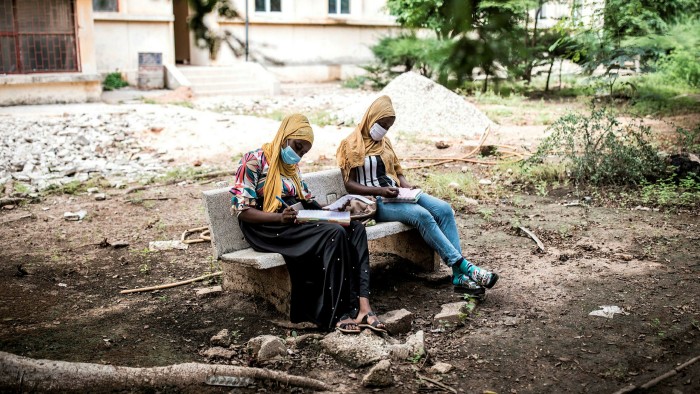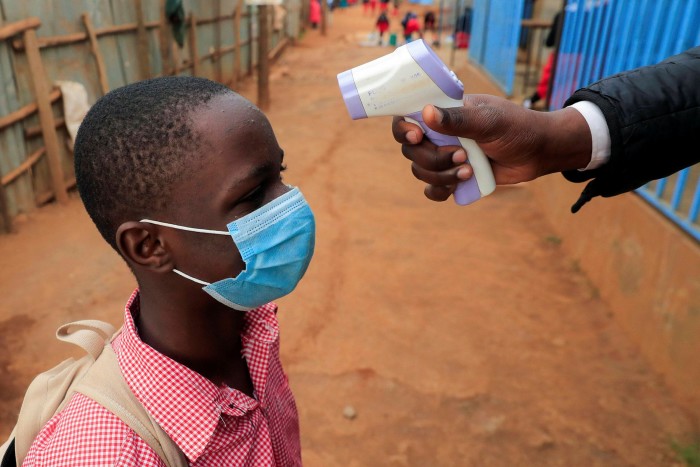Aid to tackle learning crisis set to fall short of $5bn goal

Simply sign up to the Education myFT Digest -- delivered directly to your inbox.
Donor nations are falling short of a $5bn fundraising target to support education in lower-income countries, as concerns mount over an escalating learning crisis for millions of schoolchildren around the world.
On Thursday, Boris Johnson, the UK’s prime minister, and president Uhuru Kenyatta of Kenya are co-hosting a replenishment meeting in London for the Global Partnership for Education (GPE) — a multilateral body seeking to raise fresh resources for the next five years.
But pledges so far are closer to $4bn, with critics warning that a post-Covid squeeze on government budgets, including the UK’s recent aid cuts, risk limiting efforts to help children learn.
“The tragedy is that this is a summit with no plan and no new finance, and small change in the context of what is now required to avoid the reversal of two decades of education progress,” says Kevin Watkins, visiting professor of practice at the London School of Economics and, until recently, head of charity Save the Children UK.
How serious is the education crisis?
Even before the pandemic, 258m children, globally, were not attending school, and Unesco estimates that 90 per cent of 10-year olds in low-income countries — led by those in sub-Saharan Africa — were failing to acquire basic “foundational” literacy and numeracy skills.
This learning crisis has left millions ill-equipped to progress through secondary school and achieve their potential.
The situation has been exacerbated by coronavirus, with schools closed for months, leaving up to 1.6bn children out of classes. There has been a wide variation in the extent of remote study, especially for poorer families with limited or no internet access. An estimated 24m children may not return to school, according to the Save Our Future campaign group, with some instead going to work or pushed into early marriage. The World Bank has calculated that the loss of lifetime earnings from even five months of absences could be more than $10tn.

How much money is required?
The majority of schooling, globally, is funded by countries’ government budgets and families’ out-of-pocket expenditure. But lower-income countries — many of which were providing only limited support — now face a “triple shock” of financial pressures linked to coronavirus: a squeeze on public resources, household incomes and overseas aid from richer countries.
Unesco estimates a shortfall of $150bn a year to achieve the UN’s Sustainable Development Goal of offering every child a quality education by 2030. The advocacy group Theirworld says the international community needs to provide $75bn but calculates that only $16bn was spent in 2019, with estimates suggesting a drop since then.
What are the prospects for extra funding?
The GPE is seeking $5bn in fresh donations in the period 2021-26. Estimates suggest it will only raise about $4bn this week. However, some additional resources will come from extra concessionary finance from the World Bank and other agencies, through Covid recovery programmes. There are also calls for temporary debt suspensions to ease low income countries’ budget pressures.
The Education Commission led by Gordon Brown, the former UK prime minister, is lobbying for the creation of a new International Finance Facility for Education, which would raise up to $50bn by leveraging aid to underwrite low-cost borrowing from multilateral development banks. This would be used to finance extra support. So far, the UK and the Netherlands have backed the mechanism.
What is the UK’s position?
Johnson’s government has prioritised funding girls’ education and sought to position itself as an international leader by co-hosting this week’s GPE summit.
It is pledging its “largest ever” contribution of £430m, which it says represents a 15 per cent increase on the previous three-year replenishment in 2018. But details are scant, and the advocacy group One suggests there is a reduction in overall support for education of at least 25 per cent. Education will also suffer from cuts to other activities that support schooling including nutrition, sanitation and reproductive health services.
“This makes the task of raising vital global funding for education much more difficult. Why should other countries listen to our appeals to do more when we are doing less?” says Baroness Liz Sugg, who resigned as the country’s special envoy for girls’ education last year after the government cut total aid from 0.7 to 0.5 per cent of gross national income.
Is money the main problem?
Most analysts say that increased funding is essential and has led to significant improvements in education in recent years. But many argue that too much emphasis has been placed on inputs such as building schools and encouraging attendance rather than on outcomes, such as whether children are learning.
Education campaigners would like to see a greater focus on proven approaches to enhance teaching and learning, accompanied by better measurement and accountability for policymakers and funders to ensure the delivery of “foundational skills” to more children.
Kirsty Newman, programme director for Research on Improving Systems of Education based at Oxford university, argues that focusing specifically on girls’ education can be counter-productive. Aid programmes, such as cash transfers to families to ensure adolescent girls attend school, can be less efficient than funding broader programmes to support learning for all, she says.
Comments